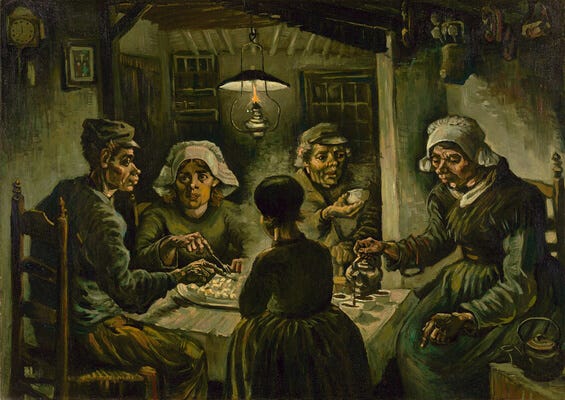Art insight: VanGogh's Potato Eaters
Dishing on how health and economics are hiding in VanGogh's masterpiece
Vincent VanGogh painted his famous “The Potato Eaters” in 1885, picturing a peasant family and their evening meal. The five figures in a dimly lit cottage is VanGogh’s only group portrait. It is also one of his most ambitious compositions and he intended it to dramatically showcase his abilities for the art markets in Paris.
VanGogh was quite the itinerant, constantly short of money, and had recently moved from Belgium back to his rural home in Nuenen, Netherlands.[1] The move helped financially since he lived with his parents and provided cheap models using his neighbors. However, VanGogh also chose this rural location strategically. Paintings of simple peasants at mealtime were popular at the time. VanGogh’s letters state the work was inspired by an 1861 painting by Charles DeGroux, Saying Grace, of a family of rural laborers saying a blessing before their meal.[2] Both paintings emphasize laborers’ hard lives while evoking sympathy through the setting’s realism.
The interest in peasant scenes and the harsh realism reflect the economic upheavals of the 1800s. In 1885, when VanGogh completed the Potato Eaters, he had spent significant time in the Netherlands, France, Belgium, and the UK, all of which were experiencing exploding rates of urbanization. In the UK in 1700, less than 10 percent of the population lived in urban areas; by 1900 it was over 60 percent. The Industrial Revolution was expanding urban opportunities, yet rural areas were still characterized by hard labor, economic uncertainty, and poor nutrition.[3]
Details in VanGogh’s scene reveal clues about the prevailing state of health during this period. The family is eating their evening meal (look on the upper left for 7 o’clock on the wall clock) in a dark and cramped cottage. The work-worn hands stand out; VanGogh wrote he wanted to show these peasants “have tilled the earth themselves with these hands they are putting in the dish ... that they have thus honestly earned their food.”[4] This contemplative gaze on “honestly earning their food” through rural labor is a symptom of urbanization’s social upheavals. Although the inventions of the Industrial Revolution were upending entire industries, such as energy, iron, and textiles, the economy-wide benefits of this change were not yet realized. Income per capita only grew a modest 0.5 percent from 1800 to 1830. Real income per capita in the U.S. has grown by more than that since April! [5]
The only dish for the family is a plate of steaming boiled potatoes on the left, while a woman pours hot coffee on the right. Within the next 20 years, at the turn of the century, nutrition would improve—boosted by economic prosperity and increased food spending—and significantly improve health spans.[6] Note there are 5 coffee cups being served, equal to the number of adults plus the child who stands at the table with her back to the viewer. Today, coffee for my children is more of a playful threat than a recommendation, why give a child such a beverage? Well, it was made with boiled water, which was much better than any alternative that didn’t boil the water.[7] Water sources, both rural and urban, were usually contaminated and contributed to the ongoing epidemics of cholera, dysentery, tuberculosis, and typhoid fever.[8] By the time of this evening meal, the world was already in its 5th cholera epidemic in a mere 70 years and was queuing up for the 6th by 1899.[9]
No matter how many are gathered around your table this holiday or however you choose to serve your potatoes, I hope this painting gives you new ways to be thankful for our blessings of plentiful nutrition and the incredible rout of sanitation and public health measures against infectious disease! Happy Holidays!
Special thanks for help on this article from Jason Najjar, Jordan Hosp, Marshall Meisel, and Collin Adams.
[1] The Art Institute of Chicago has a fun timeline of VanGogh’s life.
[2] VanGogh Museum, “What about the Potato Eaters? VanGogh Questions #2”, Vimeo video.
[3] Mokyr, Joel, “Industrial Revolution” in The Oxford Dictionary of Economic History. Oxford University Press. DOI: 10.1093/acref/97801
[4] VanGogh Museum, Amsterdam. “The Potato Eaters” Currently on view, Nov 2024.
[5] Our per capita income grew 0.55 percent. 2024 Q3 Real GDP per capita was 69,359, versus 68,977 in 2024 Q2 (2017 dollars) . FRED: Real GDP per capita. St. Louis Fed.
[6] Mokyr, Joel, “Health” in The Oxford Dictionary of Economic History. Oxford University Press. DOI: 10.1093/acref/97801
[7] If you want to read about Northern European coffee traditions and children, enjoy!
[8] Tulchinsky TH. John Snow, Cholera, the Broad Street Pump; Waterborne Diseases Then and Now. Case Studies in Public Health. 2018:77–99.
[9] Saloni Dattani (2023) “What were the death tolls from pandemics in history?” OurWorldinData.org.






I love realist art from this era, and you've done an excellent job showing how this painting reflects history, from urbanization to public health! What makes this painting especially compelling is how Vincent van Gogh's life mirrors the lives of these rural workers. Just as they were undervalued and excluded from the benefits of urban progress, Van Gogh himself faced marginalization from the art world, with his struggles of poverty and rejection reflecting the hardships of the laborers he so poignantly depicts. In this way, reading the painting as a quasi-self-portrait illuminates the shared story of both the artist and his subjects, revealing their parallel struggles.
I really love these deep dives into paintings. Please keep doing them!